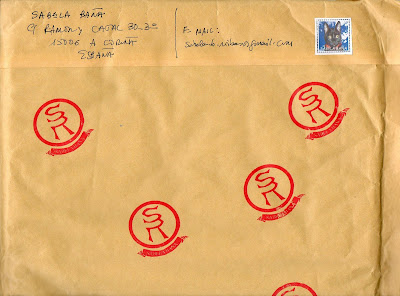INTRODUCTION FOR ASEMICS 16 - EDITION #4
Asemics 16
Collaborative Mail-Art Book Project
INTRODUCTION TO EDITION 4 – The Mountain of Signs
In 1936, Antonin Artaud visited Mexico hoping to find among its indigenous population the foundation for a new civilization that would revitalize and replace what he perceived to be the failed cultures of Europe. Artaud made contact with the Tarahumara people and in order to reach them had to traverse a desolate region which he named “The Mountain of Signs.”
Artaud’s written account of the difficult journey on horseback contains a remarkable passage where he witnessed the natural rock formations and twisted trees around him transform into marvelous inscriptions, hieroglyphs, fantastic statues depicting myths that he could not read or understand but that suggested vast systems of language chronicling an ancient world alive and energized not by reason but by an alternative source he could only name as magic.
Artaud’s vision of “The Mountain of Signs” is an early and wonderful description of the experience of encountering and creating asemics and aptly captures the spirit of this fourth edition in the Asemics 16 project, which can fairly be described as artistic magic.
The fascinating practice of asemic writing includes the invention of imaginary languages with corresponding symbols and systems for their arrangement. An asemic text suggests a language, might at times reveal traces of a known language, but ultimately cannot be read as any existing language or extinct language that has been recorded. Yet, as the pages ahead reveal, asemic writing is far from being devoid of human expression. Indeed, it succeeds on a global scale where language so often falls short.
Much of the work in this fourth edition tests the boundaries and practices of asemic writing itself as they are currently understood, further validating and extending Artaud’s experience. The artists have found inspiration for their work in all areas of their environments, creating amazing symbols and structures. As a result, new directions are presented and possibilities for expression are enlarged.
United by their involvement in the international mail-art network, contributors to this edition are accomplished painters, collage artists, photographers, conceptual artists, and visual poets. Applying their considerable talents to asemic writing (arguably most strongly aligned with literature), they have produced work that is visually stunning and provocative.
While some might seek to secure firm lines between abstract art with asemic elements and asemic texts, the work in edition four – to the contrary – disregards these distinctions between text and image in favor of creating altogether new forms. Thus, as the Asemics 16 project has progressed, the term asemic writing has given way, through a shared consensus, to the concept of asemics, which seems to be far more open and inclusive.
In their willingness to experiment and explore their imaginations, the contributors to Asemics 16 – Edition #4 open up the possibility of new worlds and new forms of expression.
De Villo Sloan
September 21, 2011
Auburn, New York, USA




















































